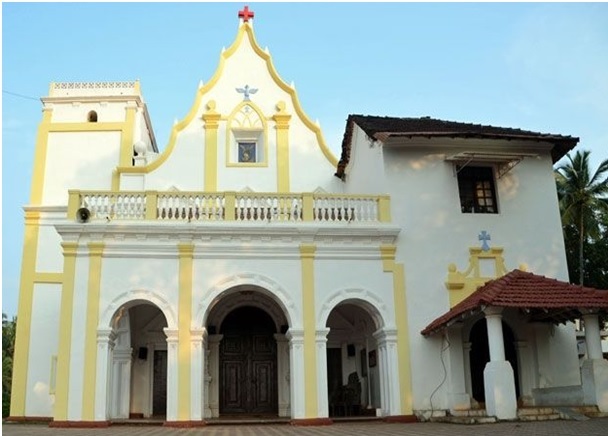
The St Michael Church in Taleigao.
It is a proud moment for about 1300 Christian families of Taleigão as their temple of faith dedicated to St Michael Church celebrates 480 years of faith. Most historians link the introduction of Christianity in Goa to the arrival of the Portuguese in 1510. However, scholars argue that Christianity existed in Goa before the Portuguese, possibly through early trade routes or missionary influence. The ancient port of Gopakapattana (in present-day Goa Velha) was an important trading centre on the trade route from the Persian Gulf to Malabar, frequented by Greeks, Romans, Persians and Arabs.
Both St Thomas and St Bartholomew availed of Roman ships frequenting the Indian ports around 52AD. Christianity in South India was spread by St Thomas and in Western India by St Bartholomew. After persecution and destruction of their Temple in 586 BCE, Jews fled and settled in different parts of the world including the western coast of India. The discovery of a cross on the bank of the River Zuari at Agasaim, dating back to the 6th century is an archaeological testimony to the existence of pre-Portuguese Christianity in Goa. However, the magnificent churches were constructed after the arrival of the Portuguese.
On November 25, 1510, Portuguese General Afonso de Albuquerque captured Goa from the Sultan of Bijapur, establishing it as a key trading hub for spices and horses with the Middle East and Rome. Inspired by Jesus' command to "go into all the world and proclaim the gospel" (Mk 16:15), Dominican friars arrived as chaplains on Albuquerque’s fleet to spread the Western Catholic faith.
The Portuguese introduced the Western Catholic Church to Goa, reinforcing their authority. Christianity began with the Franciscans in 1517, followed by the Jesuits (1542), Dominicans (1548), Augustinians (1572), Theatines (1640), Order of St John (1681), and Carmelites (1700). Goa became a diocese in 1534 and an archdiocese in 1557, with the Franciscans leading the Christianization efforts until 1542. In 1555, Viceroy Pedro Mascarenhas divided the evangelization efforts: Bardez went to the Franciscans, Tiswadi to the Dominicans, and Salcete and parts of Tiswadi, including Chorão and Divar, to the Jesuits. The Dominicans founded four churches dedicated to St Michael in Anjuna (1613), Taleigao (1544), Orlim (1568), and Nossa Senhora do Rosario (before 1543) in Old Goa.
Founded in 1544 during Bishop Joao de Albuquerque's tenure, the Taleigao church has six altars. The main altar is dedicated to the Blessed Sacrament, with the statue of St Michael venerated at the top. The tabernacle is placed at the centre, and the Holy Sacrament is exposed after the Maundy Thursday Mass. The church features two collateral altars on either side of the Eucharistic altar: the left altar is dedicated to Nossa Senhora do Rosario, while the right altar honours Jesus Crucified. Additionally, there are two more altars; one on the left has a panel for the Holy Souls, and the right altar displays a statue of Our Lady with the Infant Jesus holding a book, accompanied by a smaller statue of Jesus below.
At the main entrance, the right altar is dedicated to the Sacred Heart of Jesus, flanked by statues of the Sacred Heart of Mary, Saint Joseph, and Saint Augustine. Midway to the right is the altar of Our Lady of Fatima, erected in 1951 by the Comunidade of Taleigão. The church features an elaborately carved pulpit, adorned with a high-relief depiction of the Holy Spirit on the frontispiece. In the church compound stands a statue of Cristo Rei, erected in 1967.
In the corridor, there are five pedestals with statues of St. Dominic de Guzman, in three different depictions, with a star on the forehead, in prayer posture and with the Bible in his hand. On the next two pedestals is St Thomas Aquinas, in two different postures, one with a sun on his chest and the other holding the Blessed Sacrament. There are several chapels in the parish: Nossa Senhora da Piedade (founded in 1846 in Eugenio ward), Nossa Senhora de Lourdes (established in 1891 at Odxel), and the Capela de San Francisco Xavier de Taleigao (built-in 1928 at Kerant junction).
The Dominicans resided at the church from 1548, with Fr Diogo Madeira serving as parish priest in 1625. In 1776, the church was handed over to the Diocesan Clergy, and Fr Cristovao Lobo became the parish priest. In 1972, the church underwent a major restoration funded by Arthur Viegas, who was awarded the ‘Medalha de Proeclesia Pontificie’ by Pope Paul VI. Parish priests Fr Ventura Lourenço and Fr Aquilo Gomes undertook the renovation of the cemetery and church. The Chapel of the Blessed Sacrament was added in 2004 by Fr Carmo Martins (1997-2004), while significant renovations occurred during Fr Conceiçao D’Silva's tenure (2011-2018). Fr Cipriano Da Silva is instrumental in bringing up the St Michael Community Centre.
The parish has promoted faith through several son-of-soil priests, including ex-missionary Fr Joao Roque Fagundo Martins (1924-1989), Fr Joao Antonio Conceisao Luis, Fr Adolfo Joviano Castro Viegas (1922-2012), and Fr Lourenco Manuel Cardoso, Fr Cristovao de Melo, Fr Bernandino De Almeida, Fr Henriques Gabriel Falcao, Fr Reagan Martins, among others. In addition to other liturgical feasts, the parish celebrates the Konnsachem feast on August 21 and the St Michael feast on September 29 or the nearest Sunday thereafter.
The theme of 480 celebrations is: Strengthening faith of 480 years. Parish priest Fr Cipriano Da Silva and assistant parish priest Fr Haston Fernandes, along with the PPC, have been organizing spiritual, social, and cultural activities in the parish.